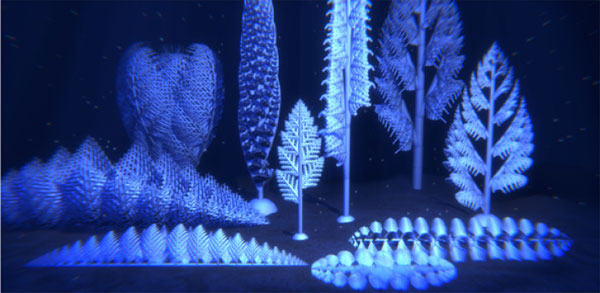Recreate the 3-dimensional structure of the oldest animals on earth
(3) The three-dimensional reconstructions show how one of the earliest animals on Earth developed, giving answers to why and when. those creatures are extinct.
A group of exotic creatures with unique shapes called rangeomorphs may be one of the first animals to appear on Earth, nicely suited to the ocean environment 575 million years ago. .
A new model built by researchers at Cambridge University has solved many mysteries around the structure, evolution and extinction of these 'primitive animals' . The research results are presented in the Proceedings of the National Academy of Sciences magazine on August 11.
Rangeomorph is the earliest large-scale creature on Earth , which exists for the time that most other life forms are only very small (only observed under a microscope). Most rangeomorphs are about 10cm tall, although some may be as tall as 2m.
These creatures lived in the ocean during the Ediacaran period, between 635 and 541 million years ago. Their bodies are made up of soft branches, each branch has a lot of smaller branches, forming a geometric form called a fractal (Fractal is a structure that shows the similarity of shapes of shapes. Different sizes), fractal geometry can be observed as fern leaves or even networks of rivers.

Rangeomorphs are not like any other creature today, which makes it difficult for scientists to determine what they have eaten, grown or reproduced, and therefore difficult to associate. Make friends with any specific modern animal group. However, despite the fact that they look like plants, the evidence shows the fact that rangeomorphs are the oldest primitive animals.
' We know that the rangeomorphs have lived too deep in the ocean so they can get their energy through photosynthesis just like plants do,' said Dr. Jennifer Hoyal Cuthill of the University's Earth Sciences Department. Cambridge, the lead researcher, said. 'It seems more like they are absorbing nutrients directly from seawater through the surface of their bodies. It is difficult for such large sized organisms in the modern world to survive only on soluble nutrients'.
'The oceans during Ediacaran's century are like a soft soup - filled with nutrients like organic carbon, while today's suspended food molecules are quickly absorbed, used by countless species. animals' , co-author of the study, Professor Simon Conway Morris said.
Beginning 541 million years ago, the environment in the oceans rapidly changed with the onset of the Cambrian Explosion - a period of rapid development when most animal groups The first large size was present in fossils and competition for nutrients increased significantly.
Rangeomorphs are often considered a "failed test" of evolution when they die quickly when the Cambrian explosion begins, but this analysis is only intended to determine whether they were How successful.
Rangeomorphs almost fill the space around them, with a very large surface area. This makes them very effective in feeding, which can absorb maximum nutrients from seawater.
'These organisms adapt quite well to their habitat, when the oceans at that time contained many nutrients and little competition , ' said Dr. Hoyal Cuthill. 'Mathematically, they filled their space in a nearly perfect way.'
Dr. Hoyal Cuthill examined rangeomorph fossils at several locations around the world, then used them to recreate the three-dimensional development and structure of these organisms, showing that how they fit into their Ediacaran environment.
However, when the event broke out in the Cambrian period began, the rangeomorphs became 'good prey' when they did not have any means of defense to deal with the beginning predators, and the composition. The chemistry of seawater changes also means that they no longer have the necessary nutrients to survive.
'At the beginning of the Cambrian period, these Ediacaran specialists were no longer alive, and nothing like them was observed again,' said Dr. Hoyal Cuthill.
- The first 3D reconstruction of DNA
- Successfully developed three-dimensional structural tissue
- The new finding shows that the human brain can create 11-dimensional space
- Meteors created the oldest rocks of the Earth
- Discover the oldest tiger species on Earth
- Latest three-dimensional map of the universe
- Decipher the mystery of the Earth's inner core
- Recreate the most ancient primates of Earth
- Recreate Big Bang radiation
- Discovering the super giant structure that can
- 14 oldest ancient artifacts in the world
- Find out the last ingredient that makes up the Earth core
 Discovered an ancient centipede fossil 99 million years old
Discovered an ancient centipede fossil 99 million years old Discovered bat-like dinosaurs in China
Discovered bat-like dinosaurs in China Discovered a 200-year-old bronze cannon of the coast
Discovered a 200-year-old bronze cannon of the coast Discover 305 million-year-old spider fossils
Discover 305 million-year-old spider fossils